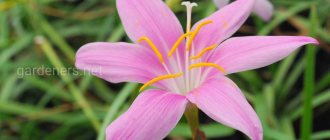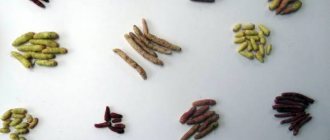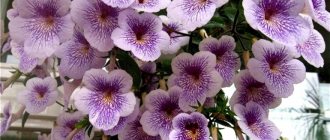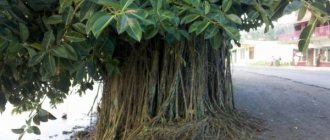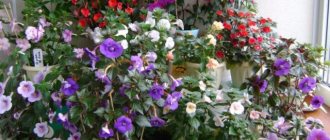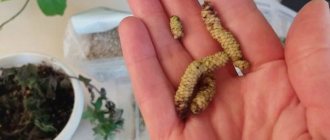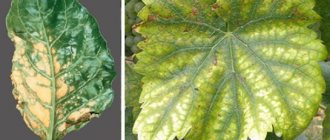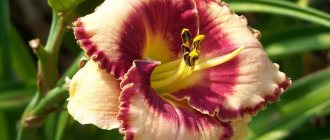Achimenes are one of the most beautiful plants. They are distinguished by a variety of shapes, colors of leaves and flowers. A feature of Achimenes is that they can only be propagated by rhizomes. What it is? This plant does not have tubers, but it does have rhizomes. What it is? They are modified, shortened shoots covered with scales. In essence, Achimenes rhizomes are peculiar seeds that ripen on the rhizome and lower part of the stem. Outwardly, they look like birch earrings. In our article we will tell you how to plant Achimenes rhizomes.
Using hedgehogs to process potatoes
Types of seedling cassettes and their use
Hazelnut - how it grows and blooms, growing a nut in the garden
Types of Achimenes
Many types of Achimenes are common in floriculture, including:
- White Achimenes (Achimenes candida) – 20-45 cm high, green or red shoots; blooms in summer, flowers 1-1.5 cm in diameter, creamy white, reddish on the outside, yellowish at the throat, with red stripes.
- Achimenes ehrenbergii - up to 45 cm high, shoots and leaves are densely pubescent; blooms in summer and autumn, large flowers up to 2.5 cm in diameter, lilac-pink outside and purple inside with a yellow throat, with orange spots.
- Achimenes erecta - 25-45 cm high, reddish shoots; blooms in summer, flowers up to 1 cm in diameter, scarlet-red.
- Achimenes heterophylla - up to 30 cm tall, with purple stems; blooms profusely in summer and autumn, the flowers are large (5 cm), the corolla tube is fiery red 3 cm, with an expanded yellow throat, spotted.
- Long-flowered Achimenes (Achimenes longiflora) – 10-30 cm high, green or red stems; blooms in summer, the flowers are large (5.5-6.5 cm) blue or bluish-purple, sometimes pink and less often white, the throat is yellow.
- Achimenes prostrate (Achimenes patens) - about 30 cm high, has green or brown stems; blooms in summer, single lilac flowers 1.5-2 cm, corolla tube widened upward, with a spur at the base.
- Fringed Achimenes (Achimenes fimbriata) – up to 30 cm high with erect drooping stems; white flowers with fringed corolla edges.
- Mexican Achimenes (Achimenes mexicana) - has weakly branching shoots 35-50 cm high; It blooms in summer and autumn, large flowers are lilac with a white throat, as well as white, pink, and purple. This species and its forms with showy flowers are most often found in the collections of gardeners.
Table: diseases and pests of Achimenes, control and prevention measures
Ring spot is a particular danger for Achimenes
Achimenes is practically not affected by such fairly common pests as whiteflies, aphids or spider mites. However, fusarium, root rot, and ring spot are especially dangerous for it.
| Disease | Signs | Treatment | Prevention |
| Root rot/fusarium | Leaves and shoots begin to lose turgor and then rot. | Dig up the plant, inspect the rhizomes, remove rotten ones, cut off damaged shoots and leaves. Treat the roots with Maxim and plant them in a fresh substrate, previously spilled with a solution of potassium permanganate. | Treat during flowering with preparations containing phytosporin and trichodermin. Do not over-wet the substrate. Follow the correct schedule when watering achimenes, that is, carry out the next watering only after the top layer has dried. |
| Ring spot | Light spots appear on the leaf blades, later turning brown. | The disease appears as a result of spraying the plant or moistening the substrate with cold, unsettled water or due to a draft. Move the plant to a sunny place, remove all damaged leaves. | Water the achimenes with warm, settled water after the top layer of soil has dried, avoid drafts. |
When to plant Achimenes rhizomes
When is the best time to plant rhizome achimenes? The optimal period is the end of February-end of April. The specific planting time depends on your conditions. It is necessary to understand that already in the initial period of growth the plant will need good lighting. At the initial stage, artificial lighting (special lamps for plants or simply fluorescent lamps) can help. If you do not have this opportunity, northern shaded windows, it is better to postpone planting to a later date, adjusting the storage temperature to a cooler one (but not lower than 12 degrees) to prevent earlier germination of rhizomes.
Table: seasonal conditions for growing ahmenes
| Spring Summer | Autumn winter | |
| Lighting | It grows well in a bright place, protected from direct sunlight. The plant can be placed on a window facing West or East, as well as a loggia or balcony. | Requires a dark place during the dormant period. |
| Temperature | The temperature is moderate (20–25ºC), the plant prefers to grow in the fresh air in summer, so it is best to take the achimenes to a balcony or loggia. | The suitable temperature for keeping Achimenes in winter is 16–18ºC. |
| Humidity | The flower requires high air humidity (85–90%). Achimenes needs to be sprayed regularly, but make sure that droplets of water do not fall on the leaves and flowers. Spray water from a spray bottle around the plant. Place sphagnum moss in the tray and moisten it periodically. Another way to create humid conditions is to place an indoor fountain on a shelf or windowsill next to the flower. | No need to moisturize in winter. |
Secrets of planting and transplanting at home
It is best to plant scaly rhizomes of Achimenes from mid-February to early March. The planting mixture must be moisture- and breathable. When making up the soil mixture, take peat, humus, sand, add perlite or vermiculite. You can also use any ready-made substrate with a slightly acidic or neutral reaction, for example, for violets.
Choose a container that is wide and shallow, since the root system of Achimenes is small. Experienced flower growers recommend planting only one rhizome in a bowl with a diameter of 7 cm; if the pot is 10 cm in diameter, then no more than three can be planted, and in a container with a diameter of 15 cm, five or six rhizomes of upright varieties. Rhizomes of ampelous achimenes can be planted more densely.
Features of transplantation - step-by-step instructions
- Shake out the top of the old soil from the Achimenes container. Select all rhizomes carefully. Examine them. Healthy rhizomes should be elastic to the touch, dense, and reddish-pink in color. Throw away anything that is darkened, dried out or moldy without regret. Healthy planting material will ensure abundant flowering.
- Divide large rhizomes into several parts, cutting them with a clean knife. Remove weak shoots.
- Provide good drainage. Place small pebbles or expanded clay in a 1.5 cm layer at the bottom of the container to aerate the Achimenes rhizome.
- Fill the pot 3/5 full with soil and moisten the substrate well with warm water.
- Place the rhizomes on moist soil at a distance of two centimeters from each other, sprinkled on top with a layer of earth 1.5–2 cm thick.
- Cover the plantings with plastic film, a transparent plastic lid or glass and place the improvised greenhouse in a dark place.
- Before emergence, do not water again, but be sure to ventilate twice a day, preferably in the morning and evening. Wipe off any condensation that has formed on the greenhouse cover. At the initial stage of growth after a period of rest, Achimenes need water only as a stimulant for germination, while the seedlings use the moisture and nutrients stored in the rhizomes in the fall. They can germinate even without additional soil moisture in a container with planted rhizomes.
- In about two to three weeks the first shoots should appear. As soon as this happens, move the container with the achimenes to a sunny place with diffused light. Achimenes does not need direct sunlight, but bright diffused light is very necessary for the formation of a compact bush and its abundant flowering.
- Moisten the soil moderately, do not allow water to stagnate in the container with the plantings, otherwise the rhizomes will begin to rot and you will not be able to save the plant. Please note that all dormant rhizomes in excessively moist soil may rot.
Planting Achimenes rhizomes
A well-formed, strong sprout can be observed in an Achimenes rhizome suitable for planting. The lower the storage temperature of the rhizomes, the later they wake up. If the rhizome of Achimenes has already begun to grow, it will not be possible to stop it, but development can be slowed down by placing such a rhizome in a cooler room with a temperature of at least 10–12 °C.
You should not abuse the plant’s patience, since in such conditions Achimenes grows weakened, and thin elongated shoots are easy to break off during subsequent planting.
Depending on the size of the rhizomes, the diameter of the selected pot and the variety being grown, 5–10 rhizomes are planted in one pot. For achimenes with a shallow root system, it is better to select containers that are not too deep, but do not forget about the drainage layer.
Achimenes rhizomes are laid out on the surface of a moist substrate, and another layer of soil 1.5 to 2 cm thick is made on top.
After planting, Achimenes rhizomes are again watered moderately, trying not to wash away the soil layer. The pot with the future flower is placed in a well-lit place, and additional lighting is provided in early spring.
In the future, moderate soil moisture will be required. From the moment Achimenes rhizomes are planted until the sprouts appear, it takes from one and a half to three weeks.
How to plant correctly: technology
Video about planting and caring for Achimenes rhizomes:
If the florist managed to inspect the specimens before they woke up or they were stored outside the ground, then he is faced with the task of planting them correctly.
How to plant Achimenes rhizomes:
- Expanded clay is placed at the bottom in a layer of 2-3 cm, soil is poured into 2/3 of the container.
- Good specimens are laid out on the surface and the soil is slightly moistened.
- After this, you need to sprinkle the rhizome on top with a 2 cm layer of soil.
- The container with the planting is placed on a southern windowsill, where there is a lot of sunlight. If there is no such window sill, then you need to organize lighting. With a strong lack of lighting, the sprouts will stretch and develop weakly, which will affect the appearance of the flower.
The plant needs time to sprout.
Under normal conditions, this takes 2-3 weeks. From time to time, the pot with the planted rhizome is moistened. This usually happens once a week. For this purpose, take warm and settled water. The temperature in the room where the flower is germinated should not fall below 22°C. Video about planting Achimenes rhizomes in the spring:
Caring for Achimenes
When the sprouts appear and begin to develop, the protective cap is removed and normal plant care begins. It consists of regular watering, spraying the room, loosening the soil in the pot and applying fertilizing (mullein, mineral complexes). Flowering usually occurs four months after the rhizomes are placed in the soil. During the flowering period, fertilizing becomes more frequent.
Planting leaf celery for seedlings
Planting pepper seedlings in the Moscow region
Black bunch tomatoes
If you want to increase the bushiness of the plant, the tops of young shoots need to be pinched. On faded stems, the tops are also removed to form side shoots with new buds.
To make plants bush better, pinch the tops of young shoots and those stems that have already bloomed. This will cause new shoots to appear on the side and fresh flowers to appear on them. Do not forget to remove dried inflorescences to allow new flowers to form in their place.
Keeping Achimenes at home
Achimenes is one of the beautiful representatives of the Gesneriaceae family, a flowering “brother” of Gloxinia and Saintpaulia. Flower growers love this plant not only for its beautiful flowers, which, with good care, delight owners throughout the active growing season. Achimenes is not a very capricious plant and adapts perfectly to home conditions; in addition, its cultivation provides extensive opportunities for collecting a wide variety of species and varieties with different colors of funnel-shaped flowers.
In its natural nature, Achimenes grows in the tropics of South America. There are more than 20 species in total; less than ten are suitable for home cultivation, but each of them blooms in its own color. Achimenes have long stems with soft, dark green, slightly pubescent leaves. Peduncles are in the form of a long tube, at the end of which bell flowers appear, forming in leaf rosettes. The flowers of the plant come in a variety of colors: from white to red and purple. In some varieties, the color of the petals is uneven and has streaks or spots.
Achimenes are plants with a pronounced dormant period followed by a period of active growing season. These charming indoor plants bloom in the spring and can bloom all season, but some varieties fade in the summer and by autumn they gain a second color, which is no longer as abundant as the first.
By the end of autumn, Achimenes begin to shed their leaves and flowering stops completely, so the plant prepares for winter. Dried shoots are cut off and the pot is put into a pantry, garage or any other dark place. At the end of winter, they take it out, water it and wait for the first shoots to appear. Achimenes is a wonderful plant for decorating a balcony, terrace and home.
Achimenes rest period
By autumn, the flowering of Achimenes ends, its leaves begin to turn yellow and die, and the plant enters the dormant stage. It is necessary to prepare the plant for this period and gradually reduce watering until it stops completely. When the ground part dries out, it is cut off. The rhizomes can be left in the same pot or transferred to the sand. At the same time, they are stored in a dark and cool place all winter at a temperature of 8-16 ° C, occasionally moisturizing. Moisten as the substrate dries, carefully watering the edges of the pot with water at room temperature, no more than once a month. Overwatering during the dormant season can cause the plant to go out of dormancy. As a result, the plant will be weakened and flowering will be weak, since in winter there is not enough light for Achimenes to grow and flower successfully. If for some reason your achimenes have come out of the dormant period, you can create additional illumination for them using fluorescent lamps, placing them above the plant at a distance of 30-50 cm.
Rules for storing rhizome
The place and method of storing Achimenes rhizomes depend on the number of specimens and the personal preferences of the grower. For example, they can be left in the same planting containers in which the plants grew, or removed for storage in another place.
In the first case, it is necessary to remove all above-ground parts of the plant, and then put the pot in a dark, relatively cool place without high humidity. The best temperature values for storing the rhizomes of the crop will be +10...+18°C, and as for care, any moisture or fertilizing should be excluded.
Throughout the winter period, you will have to periodically check the condition of the rhizomes, monitoring their awakening. If sprouts appear above the soil line, you will have to renew the top soil layer by adding fresh and loose substrate.
To prevent the appearance of sprouts, you can remove rhizomes from the ground, remove damaged and diseased roots, clean the rhizome from adhering soil and thin roots and dry, after which all that remains is to place them in dry, transparent, hermetically sealed bags, covering each layer with vermiculite, perlite or peat-sand mixture (second storage method).
In this form, it is much easier to store Achimenes rhizomes in winter, because they are not only compactly placed, but it is also much easier to control their condition. If signs of condensation appear, the bag can always be opened and the rhizomes ventilated, which helps to avoid the appearance of mold.
Did you know? The name of the genus is translated from Greek as “cold intolerant (not hibernating)”, but in the common people you can often find the designation “twisted carp”, which comes from the characteristics of the fruits.
In general, storing and further propagating Achimenes with the help of rhizomes will not be difficult, both for an experienced and for a novice gardener
Therefore, if you don’t know which flowering plant to give preference to, pay attention to the described flower
Was this article helpful?
Thank you for your opinion!
You can recommend this article to your friends!
You can recommend this article to your friends!
Yes
No
How to store Achimenes rhizomes in winter
At this time, reduce watering, and then stop altogether. The leaves of the plant soon begin to wither and dry out. When the entire above-ground part of the plant is completely dry, cut it down to the base.
After this, move the pot with achimenes to a cool, dark place with an air temperature of 16 to 18 degrees. During the hibernation period, you can lightly moisten the top layer of soil in the pot once a month. You can also sort the planting material into transparent resealable bags depending on the variety. Vermiculite and perlite provide good storage.
Autumn preparation of rhizomes for storage
In autumn, when it’s time to rest:
- Achimenes stops forming new buds;
- the plant does not produce a noticeable increase in the green part;
- the foliage, starting from the lower tiers, withers;
- The soil, due to the plant’s lower need for moisture, remains wet longer.
Having noticed the first signs of the end of the growing season, the grower should stop feeding Achimenes and begin to reduce watering. If this is not done, the rhizomes of Achimenes may go into winter spoiled or with unformed growth points and scales.
The preparation of Achimenes rhizomes for storage is facilitated not only by reducing watering and eliminating fertilizers, but also by a natural reduction in daylight hours, as well as a decrease in air temperature. If Achimenes is grown in a room where the daytime temperature is close to 30 °C, and at night it decreases by no more than 5–7 °C, the process of transition to the dormant period in plants is delayed. Such specimens completely stop watering to provoke the death of foliage and shoots.
To ensure that the rhizomes survive the winter more easily, and that the rhizomes do not dry out or begin to rot during storage, it is better to wait for the above-ground part of the plant to completely dry out and only then send it into its many-month “hibernation.”
Top dressing
Achimenes should be fed with fertilizers for flowering plants. But it is not recommended to fertilize it immediately after wintering - there are still enough trace elements left in the soil. When the plant begins to actively develop, you can feed it once every two weeks.
Read our article about proper care of bamboo, a houseplant that is considered a symbol of prosperity.
Find out all about pests of indoor plants here.
Reproduction
Achimenes reproduces in the following ways:
- Seeds. At the beginning of spring, the seeds are sown superficially in a transparent greenhouse, without covering them with soil. Seeds should be watered by spraying and ventilating regularly. At a temperature of 22 - 24 ° C, the first shoots should sprout within 14 days. With the appearance of two leaves, the seedlings dive.
- By cuttings. This method is rarely used. Cuttings are rooted in water or soil under a greenhouse. This method has a significant drawback - by the time of dormancy, the plant has not yet gained the necessary strength and may not survive wintering.
- Rhizomes. This is the most reliable method of reproduction. During a season, one rhizome can produce up to a dozen new ones. The overgrown rhizomes are separated, their sections are dried, sprinkled with ash and planted in pots. Experienced gardeners advise dipping the rhizome into a weak solution of potassium permanganate before replanting to prevent it from rotting.
Soil selection and replanting
Achimenes is not picky about the composition of the soil, but requires good drainage with a layer of 2 or 3 cm. Your pet will feel great in the soil for flowering plants. You can also prepare a mixture for it yourself from turf and leaf soil and sand in a ratio of 2:3:1 .
When choosing a pot for a plant, you should take into account that rhizomes grow almost on the surface of the soil and the root system grows from above. Therefore, the container for achimenes needs to be wide and not deep.
Achimenes is replanted at the end of the dormant period. Rhizomes are laid horizontally on the soil surface and sprinkled with a soil layer 0.5 cm high. Before the first shoots appear, it is advisable to cover the rhizomes with transparent material.
Choosing a location and lighting
Achimenes loves light, but not direct sunlight, which can burn its tender leaves. The western and eastern window is an ideal place for the plant .
In active sun, Achimenes should be shaded , but not too much. Constant shadow can affect the brightness of flowers and normal growth of stems.
The plant loves warmth and prefers a temperature of 20 - 24 °C . , achimenes needs a temperature of 10 - 15 ° C.

